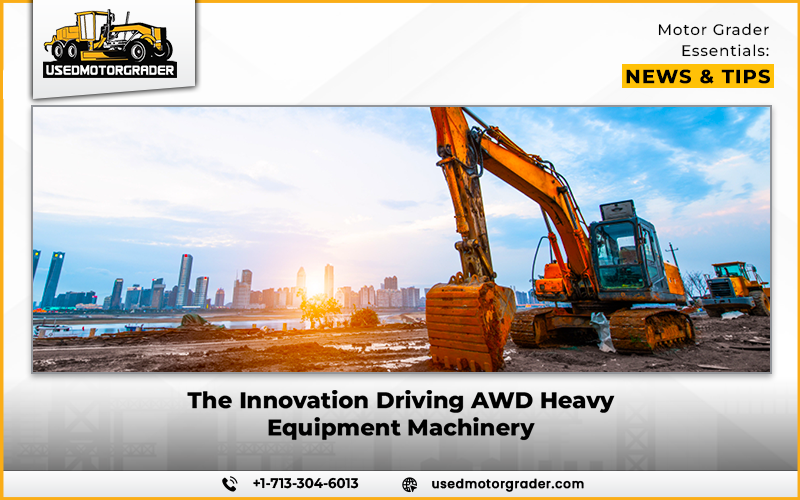In the world of construction and industrial work, traction and stability can be the difference between a project’s success and failure. This is where all-wheel drive (AWD) technology comes into play. In today’s world of Heavy Equipment Machinery, AWD is more than just a feature – it’s a game-changer that transforms performance on challenging terrains, improves productivity, and ensures that operators can work safely and efficiently. As innovation continues to evolve, AWD has emerged as one of the defining advancements that is transforming the way heavy machinery operates in challenging environments.
Evolution of AWD in Heavy Equipment Machinery
Not long ago, most heavy equipment was powered by two-wheel or partial-drive systems. While they did well under controlled conditions, they fared poorly in muddy fields, sandy roads, and uneven surfaces. This resulted in inefficiencies, safety risks, and increased operational costs.
Historical Milestones:
- The first AWD systems were used in military and off-road vehicles, which need to handle tough, unpredictable conditions.
- By the late 20th century, graders and loaders started to use AWD to increase site flexibility.
- The combination of hydraulics and improved powertrains made AWD more reliable and efficient.
- Today, AWD has gone from being a luxury to being a standard in performance-driven machinery.
Core Technological Innovations Behind AWD Machinery
AWD systems are not simple at all. They use advanced engineering and electronics to achieve power and control. These innovations make it possible for heavy equipment to adapt to unpredictable job sites without compromising on efficiency.
Key AWD Technologies:
- Automatic torque split that adjusts to ground conditions in real time
- Smart sensors that monitor wheel slippage and adjust traction as needed
- Electronic differentials for increased stability and control
- Integrated suspension system for smoother rides and less stress on components with AWD
Performance Advantages of AWD Heavy Equipment Machinery
The performance gap between AWD and conventional drive systems is clear. By providing equal power distribution across all wheels, AWD machinery ensures that operators can maintain control, even in extreme conditions.
Operational Benefits:
- Increased tractive force, enabling machines to confidently move heavier loads
- Better maneuverability in confined areas, particularly in crowded work sites
- Enhanced safety for operators working on steep slopes or uneven surfaces
- Improved tire wear due to even power distribution between wheels
For contractors, these benefits mean less downtime, more productivity, and longer equipment life cycles.
Fuel Efficiency and Sustainability in AWD Machinery
One misconception is that AWD always means more fuel consumption. In fact, modern AWD systems are designed to be as efficient as possible and produce the least amount of emissions. Sustainability is now as important as raw performance.
Green Innovations:
- Idle management systems that reduce fuel consumption when equipment is not actively performing
- Hybrid AWD powertrains that reduce emissions while still delivering power
- Regenerative braking in some electric AWD models, used to feed energy back into the system
- Telematics devices that enable managers to monitor fuel use and operator behavior for better decision-making
These eco-conscious features demonstrate that AWD is not just about power; it’s also about responsibility.
AWD Applications Across Different Heavy Equipment
AWD is no longer restricted to one type of machine. It has been extended to several classes of Heavy Equipment Machinery, and thus it is a general solution for a broad spectrum of industries.
Industry Applications:
- Motor graders: Provide accurate grading even on stony or uneven terrain
- Wheel loaders: Improved traction when handling heavy materials in quarries and pits
- Dump trucks: Can safely move loads over muddy or unstable surfaces
- Agricultural tractors: Operate efficiently in wet fields where traction is important
Whether it’s constructing a highway, excavating a mining site, or farming on wet soil, AWD makes sure performance doesn’t come second.
Challenges and Future of AWD Innovation
Like any sophisticated system, AWD has its challenges. The initial capital investment can be prohibitive, and operators need to be trained to get the most out of the technology. However, the future is promising as innovation continues to solve these issues.
Future Outlook:
- Autonomous fleets for self-driving heavy machinery using AWD
- AI-powered AWD systems that automatically adjust to terrain in real time
- Hybrid and electric AWD machines that reduce fuel costs without compromising performance
- Lightweight, durable materials for greater efficiency and less environmental impact
As technology evolves, AWD is becoming smarter, cleaner, and more essential to construction and industrial success.
In a Nutshell
AWD has redefined the capabilities of Heavy Equipment Machinery. From its origins in military vehicles to today’s sensor-driven systems, it has revolutionized productivity, safety, and sustainability in the industry. The innovation behind AWD isn’t just about mastering terrain; it’s about redefining the very essence of how heavy equipment is designed and utilized. As we look forward, the fusion of AWD with automation, AI, and eco-friendly technologies will continue to propel the industry towards a smarter, more efficient future.
FAQs
Q1. What makes AWD heavy equipment better than standard drive systems?
A: AWD offers enhanced traction, stability, and control, particularly in challenging terrains like bumpy roads or slippery surfaces. This minimizes downtime and maximizes operator safety.
Q2. Does AWD increase fuel consumption in heavy machinery?
A: Not necessarily. Modern AWD systems are designed with efficiency in mind, often incorporating fuel-saving features such as idle management and smart torque distribution.
Q3. Which industries benefit most from AWD machinery?
A: Construction, mining, forestry, and agriculture all benefit from AWD because it provides reliable performance in challenging and changing ground conditions.
Q4. What role will automation play in AWD systems in the future?
A: Automation will advance AWD by making it possible to adapt to terrain in real time, incorporate AI-based controls, and support autonomous fleets of heavy equipment.
Meta Description


